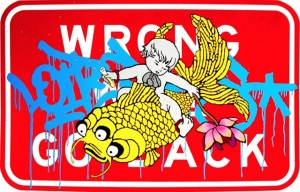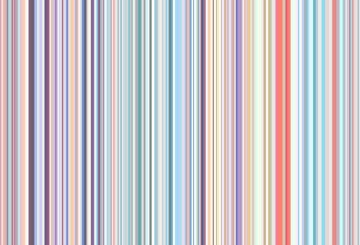Sharne Wolff follows the signs to Jason Wing‘s exhibition Parramatta River Dreaming…
I have to confess a strange predilection for road signs – well in fact it’s really an interest in text and fonts and the way things read generally. Apparently I spent hours as a kid flipping through the Sydney white pages when the A-Z was all in one big fat volume. I thought this interest was peculiar to me for many years until I discovered artists like Robert MacPherson, Vernon Ah Kee and Tom Polo, and realised that there are plenty of others out there with an interest in the aesthetic of the written word and the way words convey messages. Because road signs are designed to say a lot in just a few words there’s always that niggling temptation to see if one could do it gramatically better than the person who sits in their office, finger on chin, working out how best to say (in the most polite of ways) ‘you better get the hell out of here fast and go back the way you came or you’ll be very very sorry!!’
With this in mind all signs led me to Edwina Corlette Gallery in Brisbane to view Jason Wing’s new solo exhibition entitled ‘Wrong Way Go Back’. I was particularly keen to see this show after viewing one of Wing’s powerful installation works (a finalist in the 2009 Parliament of NSW Indigenous Art Prize).
Spray paint on aluminium, 147x230cms.
The title of the exhibition takes it name from one of the larger works entitled Parramatta River Dreaming 2010 which hangs in the front window of the Gallery. This striking work uses a recycled ‘Wrong Way Go Back’ traffic sign as a support for the bold and strongly coloured acrylics layered over the top of the text. Like several of Corlette’s current stable of artists, Wing’s journey as an artist started on the streets. It isn’t so unusual that he has therefore chosen to use discarded signs (the bounty of graffiti artists all over the world) on which to overlay his work. The painting shows a very young boy (apparently the artist as a young child) painted in strong black outline sitting astride a bright yellow three-eyed fish – which almost appears to be flying. In one hand the boy holds a pink lotus, in the other, a test tube containing a liquid, presumably water from the River.
Wing often uses the colours of his rich Chinese and Aboriginal heritage in his artwork which features a black, red white and yellow palette. Wing’s use of spray paint stems from the streets, but he also uses stencil work to explore the traditions of early aboriginal cave painting and Chinese paper cut techniques. The fish and the lotus recur in many of Wing’s works and in China are symbols of abundance and purity. The three-eyed fish perhaps implies something not quite right with the world. The recurrence of the boy in many of the works is perhaps a reference to the spirit of youth, innocence and joy. Although a personal reference, the boy is used as a device to illustrate these universal ideas.
‘Parramatta River Dreaming’ is such a strong work not least because the support has become part of the work itself and commands our attention in the same way that it does on the road. In itself this makes it stronger than a similar work painted in 2009. The artist has juxtaposed this statement with the spirit boy, giving the scene a certain naivety, which manages to draw attention, but is never too demanding or forceful. The painting evokes a ‘Who Me?’ quality that almost makes you feel like turning around to see if you’re the one being told to ‘Go Back’. Wing seems to enjoy playing with these apparent opposites.
Although the title of the painting and the use of the water symbols are intended as hints about the fragility of our environment and the desire for sustainable development, the text provides a ubiquitous reminder. Google the phrase and it is evident that it has become a catchphrase for our times – being used as a headline for issues ranging from immigration, to religion and cultural identity, aboriginal rights, trade unionism and more. Perhaps ‘Drive Slowly’, the text of ‘New Growth 2010’, is also a gentle tap on the shoulder.
Spray paint on aluminum, 100x100cms.
All of the works in this show are painted on aluminium supports – some are recycled signs and some of which the artist has had made for the purpose. The works, which are almost all painted this year, have used two distinct styles, one with similar bold outlines to ‘Parramatta River Dreaming’ in works such as ‘Flying Lotus’ and ‘New Life’. Others such as ‘Deeply Rooted’ and ‘I am Flora and Fauna’ are subtler both in style and colour.
In addition to the strong environmental theme evident in ‘Parramatta River Dreaming’ and many other works in the show, many have titles and themes of rebirth and renewal, again a constant through Wing’s body of work. Both themes blend well together with the mixed cultural references. It is refreshing to leave a show that combines serious comment with a soft spirituality and a sense of hope and optimism. The next time I see that sign on the road it’s going to make me smile.
Jason Wing
Wrong Way Go Back
21 October – 6 November 2010.
Edwina Corlette Gallery, Brisbane




Pingback: Tweets that mention Symbol and the sign | The Art Life -- Topsy.com